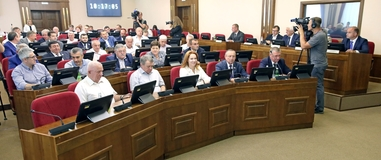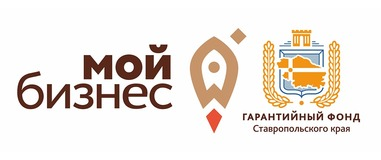hotline for investors
+7 (8652) 35-22-92, 2161
Mon-Fri: 9:00-18:00, Break: 13:00-14:00Resort-City of Pyatigorsk
Pyatigorsk is the oldest federal spa and mud resort, as well as an industrial, commercial, scientific, tourism, and cultural center of the Caucasian Mineral waters region.
Since January 19, 2010 Pyatigorsk is the center for the North-Caucasus Federal District (the only center of a federal district, which is not the central place in the region).
Pyatigorsk (founded in 1780) is located 196 km south-east of Stavropol, 24 km south of Mineralnye Vody (Mineral Waters), 525 m above sea level.
Pyatigorsk sits on the Stavropol Upland, in Pre-Caucasia (North-Caucasus) spreading far along the banks of the Pudkumok, on the south-western and southern slopes of at the foot of Mount Mashuk, 500–600 (…670) m above sea level.
There are five major peaks that reside within the city line – Mashuk (993.7 m, with a 112 meter-high broadcasting mast on top of it) and Mashuk's branch Mount Goryachaya (557.9 m); Kazachka (633 m); Dubrovka (690.6 m); Piket (565.3 m), Post (556 m), etc. The highest peak in the city is Beshtau – 1401.2 m. Its top offers a great view on the resort area and the Caucasian Range. On a sunny day you can see all the resorts around, mirror lakes, and a chain of snow-capped peaks of the Caucasus.
The urban architecture of Pyatigorsk reveals its lower (western) part with residential areas and industrial enterprises (Promzona-2) and administrative buildings, and the upper (eastern) part – at the western foot and on the southern slope of Mashuk, which is home for numerous spa and resort hotels (neighborhoods of Tsvetnik and Proval). The newer residential neighborhoods are in the north-eastern part (Belaya Romashka /White Chamomile/ and Studenchesky Gorodok /Students' City/), northern part (Mts Post and Piket – neighborhoods of Beshtau and Mount-Post), western part (Skachky and NovoPyatigorsk) of the urban area.
The resort area so rich in underground mineral waters is rather poor of surface water as there is the river Podkumok running through it (and the Kuma – running west – north-west – north) with several smaller joining rivers. These resources are shallow and do not meet all the local needs for fresh water and cannot be much used for bathing (the water is too cold). However, in the upper areas (starting in Skalisty /Rocky/ Range (III) and piercing through the Pastbischny /Pasture/ Range with beautiful valleys) these are clear highland springs that are popular among tourists. Gurgling rivers running through stones and small waterfalls are typical of the Caucasian Mineral waters region. The water for industrial, household, and resort-maintaining needs is supplied from the Kuban via a specially build pipeline.
Natural fresh lakes are scarce, while the famous Tambukan and Lysogorsk lakes (also Lake Karras and the rivers Gorkaya (salt water) and Gorkushka (bitter-salt)) contain only salt water and are valuable sources of therapeutic mud. However, from the peaks you can see mirror-like glittering lakes in the valleys, which are large water storages in Essentuki and near Pyatigorsk (man-made lakes are also to be found in Zheleznovodsk). Summer time these lakes attract numerous visitors, both from among local residents and from outside.
The nearby mountains are covered with woods full of strong oaks and snow-white birch trees, honey maples and lime trees, while in autumn this area is full of berries – cornel, hawthorn, briar, and mountain-ash.
The Mashuk forest-park is hugging the foot of Mashuk like a horseshoe joining the Beshtau forest zone running north and north-west of Pyatigorsk, thus making a specially protected reserved area (1972).
The animal kingdom near the urban area is not so diverse yet tourists are inevitably happy to see squirrels to be seen even in the smallest parks downtown, and swans swimming in Kirov Park Lake in summer.
Pyatigorsk is best known as a resort place. However, this is also a cultural center not only for the Mineral Waters Region yet for Stavropol Krai and the North Caucasus as a whole.
Pyatigorsk is an extremely interesting place with numerous attraction sites, historical monuments, culture sites and, of course, unique natural and architectural places.
Pyatigorsk Terrainkurs are well known to be of therapeutic effect for those walking here, who at the same time enjoy it. Visitors to this resort place can also enjoy a tour to Mt. Mashuk offering a beautiful view on the Main Caucasian Range and the nearest mountains – Beshtau, Razvalka, Zheleznaya, Zmeika, and there is a rope-way to transport tourists to the peak of Mashuk. This is the mountain on one slope of which you will find the well-known sinkhole Proval with a thermal mineral lake in the bottom, which attracts thousands of people annually.
Today Pyatigorsk is home to 21 spa and resort hotels with 0ver 100,000 people coming here annually both to enjoy their holiday and to get some treatment.
Therapeutic Profile
Pyatigorsk is a multi-purpose spa and mud resort area. Most of the specialized spa institutions are located in its eastern part. The major therapeutic factors are hot sulfurated hydrogen and radon mineral waters as well as the mud of Lake Tambukan. Such a variety of the factors allows treating numerous health issues here.
Mostly the health & spa hotels of Pyatigorsk specialize in treatment of diseases associated with bone and muscle, skin, gynecological issues, professional ailments (pneumatic hammer disease; professional polyneuritis), pediatric issues (children with effect of birth traumas, neurological issues, and digestion issues), namely:
Diseases of peripheral nervous system;
Mono- and Polyneuritis including those of toxic etiology;
Diseases of locomotor system (bone & muscle system and connective tissue);
Osteochondrosis vertebralis;
Post-traumatic arthritis;
Rheumatoid arthritis;
Polyarthritis;
Osteoarthrosis;
Digestion system diseases (see indications for Esentuki and Zheleznovodsk resorts;
Skin diseases;
Psoriasis;
Eczema;
Neurodermatitis;
Hives;
Dermatitis;
Systemic sclerosis;
Fishskin disease;
Seborrhoea;
Acquired leukoderma,
Skin itch, etc. (except fungi);
Blood vessel diseases;
Obliterating endarteritis,
Obliterating atherosclerosis;
Winiwarter-Buerger disease;
Raynaud's disease,
Widespread vasculitis;
Varicose veins in limbs;
Postthrombophlebitic syndrome;
Gynecological diseases;
Chronic inflammations (except TB);
Infertility (incl. of endocrine origin);
Menopausal syndrome;
Endometriosis;
Professional ailments;
Pneumatic hammer disease;
Professional polyneuritis.
Mineral Waters
Of all the therapeutic factors in Pyatigorsk, mineral springs are the most important ones – their history of discovery, research, and use is closely connected to Pyatigorsk itself, which has long been recognized as the cultural and administrative center of the Caucasian Mineral Waters region. Given the unique variety of mineral springs concentrated on a small area around Mashuk, Pyatigorsk is often called a Natural Museum of Mineral Waters. There was a long time when only sulfurous springs were used for treatment purposes (such springs open out of the cracks in Mount Goryachaya), so the place there was named Goryachevodsk. However, the extremely springs Cold Narzan and Hot Narzan discovered in 1902 and 1914, respectively, were not used for therapies, even though extremely efficient. The radioactivity of sulfurous waters in Pyatigorsk was known as early as in 1913, discovered by A.P. Sokolov, a physicist, in the early XX Century, yet it had not been until 30-40 years ago that radon waters found their wide use.
Following the current classification, the mineral waters of Pyatigorsk are divided into the groups below:
Carbonated waters (hot, warm, cold) – Type 1 (Pyatigorsk);
Carbonated sulfurated-hydrogen waters with complex ion-salt composition – Type 2 (Pyatigorsk);
Radon waters – Type 3 (Pyatigorsk);
Mineral waters of (Type of Essentuki) (carbonated and carbonated sulfurated-hydrogen)
Balneological spa waters "with no specific elements and properties" (nitric therms; methane waters saturated with iodine and bromide; poorly carbonated chloride-sodium water (Type of Arzni /Armenia/)).
Here, in Pyatigorsk, on the southern slope of the mountain you will find a unique combination of over 40 mineral springs whereas 28 of them are used both as spa sources and for various types of therapies. The high temperature of the water means that it is coming up from a depth of no less than 1,000 meters. There are four major groups mineral water to be found in Pyatigorsk.
Carbonated sulfurated-hydrogen springs. This group of hot sulfurated springs has been known since ancient times and is a special piece of pride for the resort area. The most famous ones include Lermontov Well № 1 and 2; Novaya Burovaya; Burovaya № 16; Pushkinsky Well; Narodny Well. Their temperature is rather high (up to 50 °C) while they have a low salt content (up to 5 g/l) and an increased content of radium and its isotopes, a therapeutically active concentration of sulfurated hydrogen (10 mg/l) and silicon (50 mg/l). These are mostly used as spa waters (mineral bath) even though you can also enjoy some drinking water as well.
Drinking carbon-bicarbonate-chloride-sulfate-sodium-calcium springs (with no content of sulfurated hydrogen) – Krasnoarmeisky Wells № 1, 2, and 3. This is iron-saturated water with no sulfurated hydrogen with a temperature of 20-26 °C and carbon dioxide content of 1.5-2.0 g/l. Such springs are also found on the southern slope of Mashuk and include Warm Narzan, Cold Narzan, and Well № 4.
Carbonated bicarbonate-chloride-sodium springs with a chemical composition that is nearly similar to the famous spring of Essentuki-17. They are widely used for treating gastro-intestinal diseases and liver issues. Similar are also Well № 14 (at Lower Pushkin Baths); Well № 17 (near Tsvetnik); Well № 20 (Lermontova Street); Well № 30 (Kirova Street).
The resort place also offers spa waters – balneological waters of nitric therms; methane waters saturated with iodine and bromide; poorly carbonated chloride-sodium water (Type of Arzni /Armenia/)), and sour-bitter waters of Mt. Post.
Radioactive waters belong to the group of poorly carbonated and rich in radium emanation. Their ion composition is similar to the main type of Pyatigorsk water, yet with a lower level of minerals (up to 2.3 g/l), and with nearly no carbon dioxide and sulfurated hydrogen. However, their radon concentration varies between 5 to 274 nCi/l. The lower group of radon waters is located in Teplosernaya Street while the upper group is to be found around the Academic Gallery. Hot Sulfurous Wells № 1, 2, and 3 (concentration of sulfurated hydrogen up to 2-3 mg/l) were discovered in 1824 and they are located at the radon clinic. Apart from that there radon water supplied from Well № 113 (Beshtau pool), which feeds the Upper radon clinic.
The Beshtau pool of mineral radon waters is located 8 km west of Pyatigorsk on the eastern side of Beshtau. The chemical composition of water from Well № 113 makes it low in minerals; radon concentration is 180-210 nCi/l (6660-7770 Bq/l).
Therapeutic Mud
Another asset of the resort area is the widely used therapeutic mud of Lake Tambukan, which lies 12 km south-east of Pyatigorsk, on the edge between Stavropol Krai and Kabardino-Balkaria. The mud is delivered from the lake to specially designed mud-storages in clinics after which it is used for application, general mud baths, mud tampons, and electric-mud therapy. Pyatigorsk is the second popular place in the Caucasian Mineral Waters area (after Essentuki) offering mud therapy.








